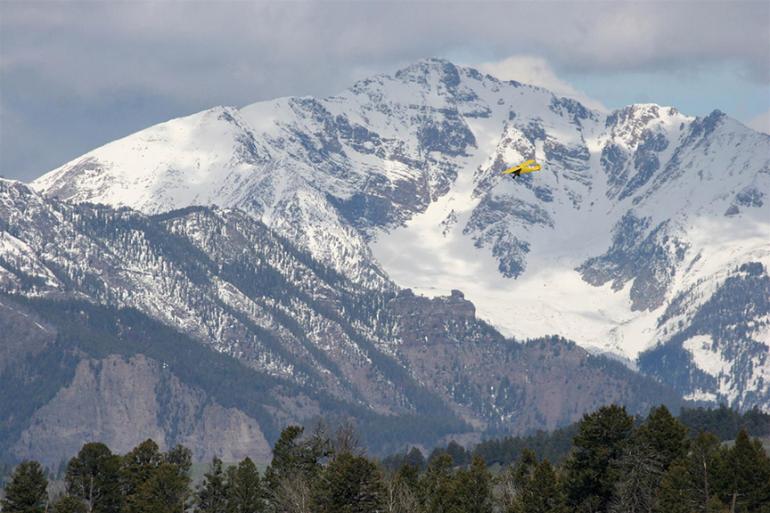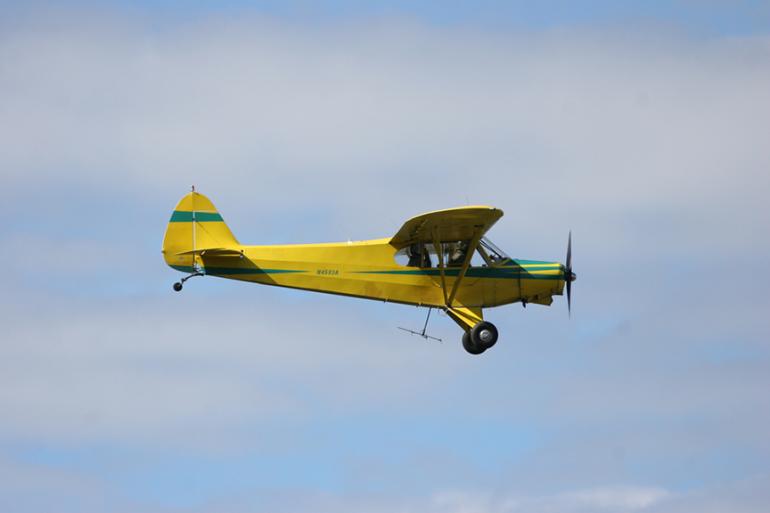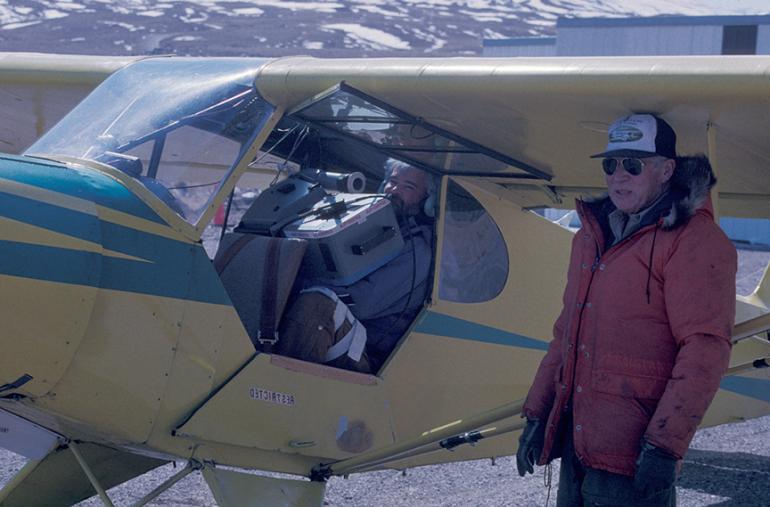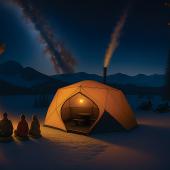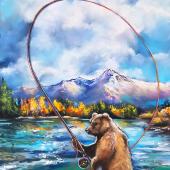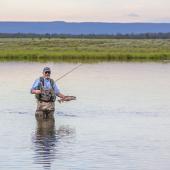Wildlife Wingman
Pilot Roger Stradley tracks from the air.
It’s 6:15 on a cool, clear morning in May and I’m waiting for my ride at the Gardiner airport—a term I use loosely, as it’s no bigger than a strip of flypaper, with a few timeworn buildings off to one side. Finally, I see it—a yellow dot in the sky, backed by the ocher streak of a landmark known as Devil’s Slide.
As the winged “dot” begins to take shape, I glance over at two bison standing obstinately on the runway. It’s an unusual obstacle, but the small plane glides right over them and lands at the end of the strip without so much as a flinch from the 2,000-pound beasts. Out climbs Roger Stradley—a 75-year-old pilot who has surveyed southwest Montana’s fauna alongside wildlife biologists since the 1960s.
It all started with Roger’s father Jim, who served as a flight instructor for the Army Air Corps in Bozeman during World War II. After the war, he moved his wife and two sons to Bozeman and opened Gallatin Flying Service in 1950, which Roger and his brother, David, now co-own.
Roger’s partner in the sky is a yellow Piper Super Cub PA-18 his father purchased in 1956. “They don’t make them anymore so I’ve had to rebuild it three times,” he says. “But they’re the best for wildlife surveys because they can handle tight turns and fly slow enough to see the animals.”
“Ready to go?” asks Roger. I nod and scramble into the teacup-sized seat just behind Roger’s and we lift off with the effort of a leaf on the breeze. Today, we’re searching for nesting bald eagles and ospreys along Yellowstone Park’s rivers and lakeshores. Our first sighting is a bald eagle nest jammed into the top of a Douglas fir along the Gardner River—an adult feeds an eaglet in the giant stick nest as we soar overhead. Continuing up the Gardner until it joins the Yellowstone, we slow down and circle an osprey nest balanced atop a rocky spire. Bison and elk graze on the plateau above the river, and I scan the terrain unsuccessfully for bears.
Although Roger’s flying is smooth, the low-altitude circling eventually proves to be too much for me and I unload my morning coffee and bagel into a Ziploc bag. Twice. “Hey look. There’s a bald eagle nest off the left wing,” Roger calls out. Silence. “Hey Lisa, you okay back there?” Thankful that Roger can’t see me slumped over my Ziploc, I finally manage to mumble a pathetic, “Not feelin’ so good, Rog.”
Flying is clearly not for everyone, but Roger never seems more at home than when he’s in the air. It’s not surprising, when you consider his training. His father had some interesting teaching tactics, like making him fly home in the dark using only the lights on the ground for reference. “In the mountains, you gotta know where you are,” Roger says.
As a result, Roger’s homing instinct is like that of the animals he seeks. Recently, the Federal Aviation Administration dinged him for flying with a broken compass. Roger is not a rule-breaker or renegade pilot—he just doesn’t need instruments to get around. He knows southwest Montana so intimately that he once helped a game warden catch a poacher. The warden showed Roger a photo of a mountain lion the hunter claimed was killed in Paradise Valley. In the background was a stump. “You think you might be able to take me there?” asked the game warden. “Maybe,” Roger replied. They lifted off and in a short while, Roger pointed to a stump on the ground and said, “That’s your stump.” It was nowhere near where the hunter described. This is the kind of knowledge that only comes from a lifetime of paying attention.
Roger pays attention to the stories of the animals, too. He’s the principal pilot for the Yellowstone Wolf Project, a job he takes personally. In 2009, the Delta pack—the most remote pack of wolves in the Lower 48—lost all their radio collars, which were the only way biologists had to keep tabs on them. On a cold February morning, Roger flew to their home range in Yellowstone’s Thorofare region to find them. He knew of a few places they might be and started there, eventually picking up their tracks in the snow. He called Doug Smith, senior biologist for the Yellowstone Wolf Project, and they put together a capture operation in a matter of hours while Roger kept tabs on the wolves. They managed to collar three wolves that day.
Roger has flown in search of just about every animal species in Montana: moose, beaver, waterfowl, even sage grouse and fish. He once saw 14 mountain lions in one day. He’s logged about 70,000 hours of flight time. String those hours together and he’d be in the air for eight years without ever landing. Surely, I assume, after 70,000 hours he must have a near-miss story. Nope. Tom Carleson, a retired FWP biologist says, “With Roger, safety always came first. If Roger said the conditions weren’t good, then you listened. That’s why he’s still flying.”
Months after our flight together, I ask Roger why he continues to fly well past retirement age. He stammers a bit and then his wife, Ann, chimes in. “I’ll tell you what I think he gets out of it—being a pilot for wildlife is sort of like being a prospector. Over the next hill you might find a pot of gold.”
Roger’s pot of gold is the lost Delta pack he found that cold February morning, or coming over a rise and seeing the afternoon sun light up the Bridgers. It’s about needing to know what lies beyond the next ridge—a sentiment that all outdoor adventurers share. That’s why he’ll continue to fly as long as he’s healthy.
It’s 10am and we’ve managed to check most of the eagle nests, so we bank a tight turn and head back to Gardiner. Along the way, Roger spots two wolves loafing by Grizzly Lake and circles them to get a better look. I start feeling queasy again and reach for a fresh Ziploc. And then Roger gives me a piece of advice. “You have to lean with the Cub rather than against it. If you go against the airplane you’re putting the G-load on your ear and that’s what makes you sick.” I lean in and stuff the Ziploc back in my pocket.
As we approach the airport I’m relieved to see the bison have moved on. We land smoothly and I stumble out of the plane, a little disoriented. I stick around to watch him lift off, like he’s done thousands of times before. He’s headed back to Bozeman, but I know he’ll be in the air tomorrow, searching for another pot of gold.


